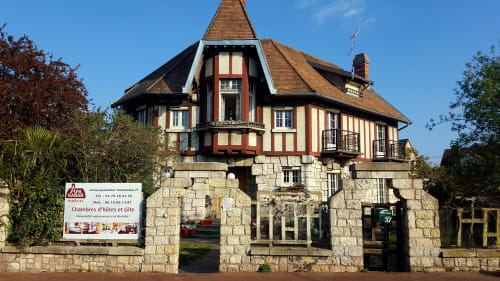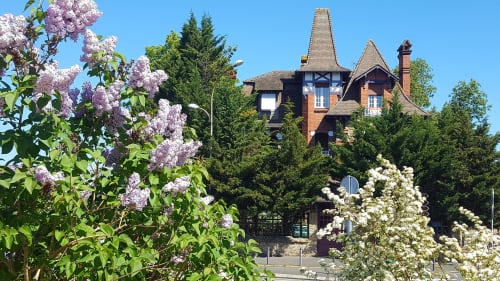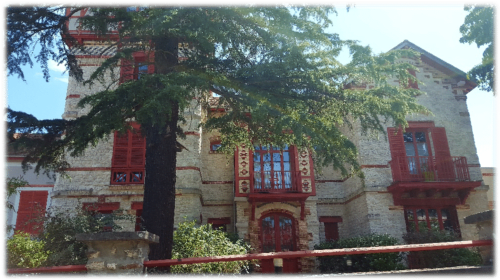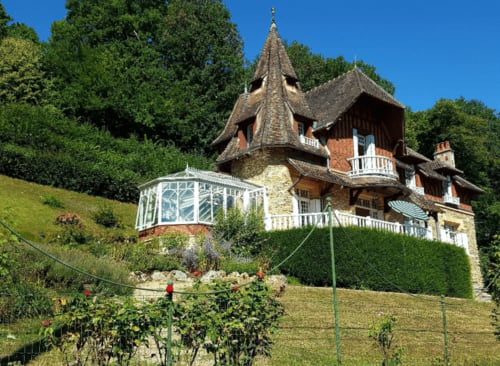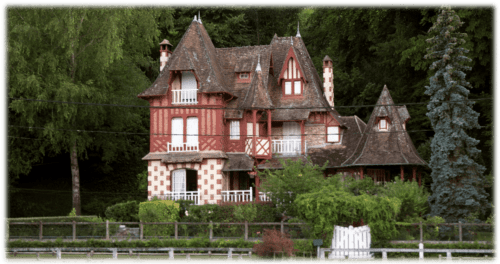The scaries
1. Le Mesnil, La Rochette (Apakabar Homestay)
Address : 37 avenue du Général Leclerc, La Rochette - 8 min walk from Melun station
Located at the exit of Melun on the national road leading to Fontainebleau stands an atypical residence that evokes Grimm's fairy tales or Snow White's house. Built in 1934 by the Parisian architect A. Dumesny, this Neo-Norman style house was named Le Mesnil. It was designed on the model of the other "Affolantes" on the banks of the Seine: a first floor in cut stone, raised by a few steps, supports a half-timbered second floor in the color of wine, while the three rooms on the second floor were built under the converted attic. The complex silhouette of the ensemble makes the house picturesque, especially the small turret that surmounts the imposing main entrance, which is richly decorated with flowers in the summer. After having served as a medical house, "la maison du Docteur Jougleux", the building was completely renovated in 2018 to be transformed into a guest house and gîte. Le Mesnil was thus renamed Apakabar Homestay (www.apakabar-homestay.fr), this strange word meaning "How are you?" in Indonesian. The mistress of the place is indeed Javanese and welcomes you in an exotic atmosphere with the colors of Bali, Java or Borneo.
2. Le Pavillon de la Croix Saint-Jacques, Dammarie-les-Lys
Address : 649 Rue Rousseau Vaudran, Dammarie-les-Lys - 15 min walk from Melun station
3. Villa Boussaingault, Melun
Address : 1 place Chapu, Melun ; 10 min walk from Melun station
Owned by the department of Seine-et-Marne until recently, this imposing villa is located just before the bridge upstream from Melun on the left bank of the Seine. Facing the small square of Place Chapu, it turns its back to the river, unlike the other Affolantes.This building is part of the Augereau housing estate, which was created in 1907 by the city of Melun on the ruins of former barracks. The house was built a year later on a 1000 m2 plot by a wood and coal merchant, Arthur Boussaingault.The complexity of its large flat tile roofs gives this two-story villa a picturesque look, complemented by a varied treatment of the walls: tower covered with bricks and false pan de bois, millstone and limestone rubble embellished with red brick courses. The accesses to the property are surmounted by porches covered with tiles. The house has been divided into several apartments.
4. La Villa Raulin, La Rochette
Address : 8 rue de la Forêt, La Rochette ; 33 min walk from Melun station
This large original house in cut stone was built in the center of the village of La Rochette by Gustave Raulin. He was an architect for the City of Paris and collaborated with Charles Garnier on the construction of the Paris Opera House at the end of the 19th century. Dominating the central building, a large square corbelled tower, "a clever mixture of medieval architecture and pigeon house" according to M.F. Laborde, gives this residence a unique character. The top floor of this tower, lit by a large bay window, once housed an architecture and painting workshop. The facade is decorated with friezes of glazed red bricks that are found around the bays and along the roofs. The loggia over the entrance door was repainted in the same red color during the rehabilitation of the house by the architect Michel Frénot. The Raulin House is now subdivided into apartments.
5. Le Clos-Barbeau, Bois-le-Roi
Address : 3 quai de la Ruelle, Bois-le-Roi ; 12 min walk from the station of Bois-le-Roi
Built in 1905 by the famous architect Louis Périn, then enlarged in 1912, the Clos-Barbeau is one of the most beautiful houses on the banks of the Seine. Located on the left bank of the Seine near the bridge leading from Bois-le-Roi to Chartrettes, it seems to have been built near a site of which one finds a trace until the year 626, according to an inscription engraved on a stone at the entrance of the building. The name Barbeau comes from a local legend that tells of a fisherman who pulled up a barbel (a fish) from the Seine at this place, inside which he discovered a diamond, or according to other versions, a precious ring that Saint Loup, archbishop of Sens, dropped into the Seine near Melun. The first floor, whose walls are made of ashlar, has two large arched bays that light up a large room. The second floor is half-timbered, with woodwork that has been repainted in red by the architect Michel Frénot, giving this dreadful house a singular appearance. A remarkable feature of this building is the wooden footbridge that leads from the main building to another hexagonal building located further back. Today it is divided into 13 condominiums.
6. Chantemerle, Bois-le-Roi
Address : 5 quai de la Ruelle, Bois-le-Roi ; 13 min walk from the station of Bois-le-Roi
At the beginning of the 20th century, the architect Louis Périn transformed a pre-existing house with a medieval-style turret by adding various elements. He installed his studio under the roof. This house with mixed medieval and Art Nouveau references now houses a rest home.
7. Le Vieux-Logis, Bois-le-Roi
Address : 22 quai de la Ruelle, Bois-le-Roi ; 15 min walk from the station of Bois-le-Roi
Neighbor of the previous one on the towpath of Bois-le-Roi, the Vieux-Logis has a particularly original history. Its builder Emile Rochard bought the facade of a famous Amiens residence dating from the 15th century, successively called the "Auberge de l'asne-Rayez" in the 18th century, then the "Maison des Ramoneurs". Heavily damaged by a fire in 1890, this façade was completely dismantled in 1897, then exported to Bois-le-Roi, where it was plastered onto a pre-existing house on the banks of the Seine. This facade offers a painted and carved wood assembly colored in dark green, which contrasts radically with the bright red of the Clos Barbeau. Facing east with a view of the Seine, this facade is made up on the first floor of large bay windows that let in the morning light. In addition to its façade, the most remarkable aspect of this house is its very high and sloping roof, which has three floors of attic space lit by dormer windows of decreasing size.
8. Les Roches, La Rochette
Address : quai de Seine (Chemin de Halage), La Rochette ; 40 min walk from Bois-le-Roi station
The Affolantes with main walls in millstone surmounted by red brick floors follow one another on the towpath of La Rochette. Most of them are surrounded by a magnificent and well-kept garden overlooking the Seine.
Flamboyant gothic style, La RochetteClose to the previous one, this gothic style house with its slate roof, its wooden turret and its lintels, is made of a mixture of millstone and bricks, with ornamental elements in plaster and wood.
Flamboyant gothic style, La RochetteClose to the previous one, this gothic style house with its slate roof, its wooden turret and its lintels, is made of a mixture of millstone and bricks, with ornamental elements in plaster and wood.
9. La Roseraie, La Rochette
Address : 17 quai de Seine (Chemin de Halage), La Rochette ; 40 min walk from Bois-le-Roi station
Built in 1908 on the banks of the Seine in La Rochette, the Roseraie is a picturesque residence mixing millstone walls, brick walls, red half-timbering and multiple towers with pointed roofs. Without doubt one of the most original Affolantes in the region.
10. Le Manoir de Seine, Chartrette
In the years 1920-1930, the modern movement advocated a rational architecture and rejected ornaments and references to the past. However, in 1932, Louis Périn had the Manoir de Seine built in Chartrettes, an extravagant residence in a style so appreciated in the 19th century.
